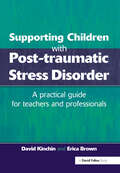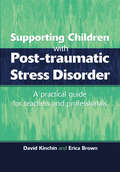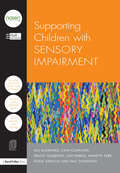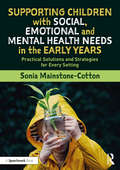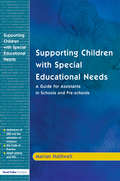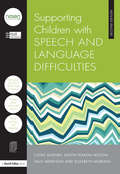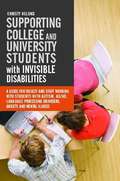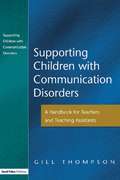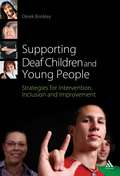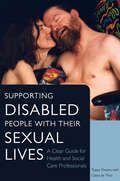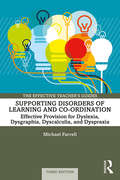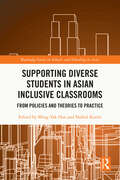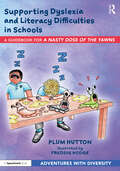- Table View
- List View
Supporting Children with Post Tramautic Stress Disorder: A Practical Guide for Teachers and Profesionals
by David Kinchin Erica BrownIt is estimated that at any one time around 135,000 school children are suffering from post-traumatic stress disorder (PTSD). They may be survivors of abuse (physical, emotional or sexual) or bullying. Some may have been involved in a road accident, an accident at home or any other traumatic event. This book provides teachers, support staff and other educational professionals with the information they need to, really understand the implications of PTSD, ably and effectively support and educate a traumatized child, address questions such as what can cause PTSD in young people? and understand how PTSD might affect the education of children at school.
Supporting Children with Post Tramautic Stress Disorder: A Practical Guide for Teachers and Profesionals
by David Kinchin Erica BrownIt is estimated that at any one time around 135,000 school children are suffering from post-traumatic stress disorder (PTSD). They may be survivors of abuse (physical, emotional or sexual) or bullying. Some may have been involved in a road accident, an accident at home or any other traumatic event. This book provides teachers, support staff and other educational professionals with the information they need to, really understand the implications of PTSD, ably and effectively support and educate a traumatized child, address questions such as what can cause PTSD in young people? and understand how PTSD might affect the education of children at school.
Supporting Children with Sensory Impairment (nasen spotlight)
by Hull City CouncilThis book provides a quick and easy reference guide to different types of sensory impairment, including causes, symptoms and the implications on teaching and learning. With most children and young people with hearing or visual impairments attending mainstream schools, this book explains the most effective and practical strategies for use in mainstream classrooms. Fully up to date with the 2014 SEND Code of Practice, this accessible resource is split into two sections: Supporting Children with a Hearing Impairment and Supporting Children with a Visual Impairment. The wide-ranging chapters include: Educational access for pupils with hearing loss Teaching phonics Teaching deaf pupils with English as a second language Identifying children with visual impairment Classroom management Adapting resources This practical text provides strategies to use in schools to ensure that children with sensory impairments are fully supported. Featuring useful checklist and photocopiable resouces, it contains a wealth of valuable advice and tried-and-tested strategies for teachers and support staff working in early years settings, schools, academies and colleges.
Supporting Children with Sensory Impairment (nasen spotlight)
by Hull City CouncilThis book provides a quick and easy reference guide to different types of sensory impairment, including causes, symptoms and the implications on teaching and learning. With most children and young people with hearing or visual impairments attending mainstream schools, this book explains the most effective and practical strategies for use in mainstream classrooms. Fully up to date with the 2014 SEND Code of Practice, this accessible resource is split into two sections: Supporting Children with a Hearing Impairment and Supporting Children with a Visual Impairment. The wide-ranging chapters include: Educational access for pupils with hearing loss Teaching phonics Teaching deaf pupils with English as a second language Identifying children with visual impairment Classroom management Adapting resources This practical text provides strategies to use in schools to ensure that children with sensory impairments are fully supported. Featuring useful checklist and photocopiable resouces, it contains a wealth of valuable advice and tried-and-tested strategies for teachers and support staff working in early years settings, schools, academies and colleges.
Supporting Children with Social, Emotional and Mental Health Needs in the Early Years: Practical Solutions and Strategies for Every Setting
by Sonia Mainstone-CottonThis accessible book offers essential guidance and practical ideas for Early Years staff to support children with social, emotional and mental health (SEMH) needs. It draws upon a wealth of experiences and insights to explore what SEMH is, why children may have SEMH needs, and what this can look like, giving practitioners the confidence they need to understand early signals and signs. Chapters share practical tools, activities and strategies, exploring topics that include: environment routines and transitions sensory experiences feelings and emotions the role of the adult. A range of case studies and resource suggestions are woven throughout, bringing the theory alive with first-hand advice from a variety of professionals, including educational psychologists, play therapists and Forest School specialists. This book is a refreshing and practical guide, and an essential read for all Early Years practitioners looking to cultivate a supportive and compassionate environment.
Supporting Children with Social, Emotional and Mental Health Needs in the Early Years: Practical Solutions and Strategies for Every Setting
by Sonia Mainstone-CottonThis accessible book offers essential guidance and practical ideas for Early Years staff to support children with social, emotional and mental health (SEMH) needs. It draws upon a wealth of experiences and insights to explore what SEMH is, why children may have SEMH needs, and what this can look like, giving practitioners the confidence they need to understand early signals and signs. Chapters share practical tools, activities and strategies, exploring topics that include: environment routines and transitions sensory experiences feelings and emotions the role of the adult. A range of case studies and resource suggestions are woven throughout, bringing the theory alive with first-hand advice from a variety of professionals, including educational psychologists, play therapists and Forest School specialists. This book is a refreshing and practical guide, and an essential read for all Early Years practitioners looking to cultivate a supportive and compassionate environment.
Supporting Children with Special Educational Needs: A Guide for Assistants in Schools and Pre-schools
by Marian HalliwellFirst Published in 2004. Routledge is an imprint of Taylor & Francis, an informa company.
Supporting Children with Special Educational Needs: A Guide for Assistants in Schools and Pre-schools
by Marian HalliwellFirst Published in 2004. Routledge is an imprint of Taylor & Francis, an informa company.
Supporting Children with Speech and Language Difficulties (nasen spotlight)
by Hull City CouncilCompletely revised and updated in light of the new SEND 2014 Code of Practice, this new edition describes the different types of difficulties experienced by pupils with speech, language and communication needs. It will help teachers and other professionals to feel more confident by providing expert guidance and practical strategies, and as a professional development tool, will also encourage outstanding practice by suggesting ideas and materials for in-house training sessions. The wide-ranging and accessible chapters explore topics including: Listening skills Phonological awareness Comprehension of language Activities for circle time Working with parents Featuring useful checklists, templates and photocopiable resources, this practical resource contains a wealth of valuable advice and tried-and-tested strategies for identifying children and young people with speech, language and communication needs, ensuring they have the support they need to make exceptional progress.
Supporting Children with Speech and Language Difficulties (nasen spotlight)
by Hull City CouncilCompletely revised and updated in light of the new SEND 2014 Code of Practice, this new edition describes the different types of difficulties experienced by pupils with speech, language and communication needs. It will help teachers and other professionals to feel more confident by providing expert guidance and practical strategies, and as a professional development tool, will also encourage outstanding practice by suggesting ideas and materials for in-house training sessions. The wide-ranging and accessible chapters explore topics including: Listening skills Phonological awareness Comprehension of language Activities for circle time Working with parents Featuring useful checklists, templates and photocopiable resources, this practical resource contains a wealth of valuable advice and tried-and-tested strategies for identifying children and young people with speech, language and communication needs, ensuring they have the support they need to make exceptional progress.
Supporting Children With Visual Impairments (Inputs Ser. (PDF))
by Special Children StaffThis is one of a series of books designed to help parents and teachers to identify common impairments, providing them with clear and concise explanations of the disability, and providing a glossary of terms
Supporting College and University Students with Invisible Disabilities: A Guide for Faculty and Staff Working with Students with Autism, AD/HD, Language Processing Disorders, Anxiety, and Mental Illness
by Christy OslundWith increasing numbers of students with invisible disabilities attending college and university, faculty and staff find themselves faced with new challenges. This practical handbook provides lecturers, tutors, disability services, and administrative staff with an overview of the invisible disabilities they may encounter, dispelling common myths and offering practical advice to support the needs of these students. Students with invisible disabilities are often academically talented but struggle with certain aspects of higher education such as keeping track of appointments or maintaining concentration in lecture halls. By providing detailed information on a range of disabilities including autism, AD/HD, dyslexia, OCD, and affective disorders, this book facilitates a better understanding of the unique needs of these students and what their strengths and limitations may be. With ideas for adapting teaching methods, offering suitable accommodations, and improving institutional policy, this is vital reading for all university faculty and staff.
Supporting College and University Students with Invisible Disabilities: A Guide for Faculty and Staff Working with Students with Autism, AD/HD, Language Processing Disorders, Anxiety, and Mental Illness (PDF)
by Christy OslundWith increasing numbers of students with invisible disabilities attending college and university, faculty and staff find themselves faced with new challenges. This practical handbook provides lecturers, tutors, disability services, and administrative staff with an overview of the invisible disabilities they may encounter, dispelling common myths and offering practical advice to support the needs of these students. Students with invisible disabilities are often academically talented but struggle with certain aspects of higher education such as keeping track of appointments or maintaining concentration in lecture halls. By providing detailed information on a range of disabilities including autism, AD/HD, dyslexia, OCD, and affective disorders, this book facilitates a better understanding of the unique needs of these students and what their strengths and limitations may be. With ideas for adapting teaching methods, offering suitable accommodations, and improving institutional policy, this is vital reading for all university faculty and staff.
Supporting Communication Disorders: A Handbook for Teachers and Teaching Assistants
by Gill ThompsonThis practical handbook provides SENCOs, class teachers and teaching assistants with a step-by-step guide to the identification of speech and language disorders, a basic knowledge of the underlying causes and guidance for developing strategies for support and intervention in the classroom. It gives a foundation for assessment and differentiation, which will help the teacher or teaching assistant to work effectively in collaboration with speech and language therapists. It suggests appropriate materials and programmes of work for enabling the child to access the curriculum as fully as possible. The book includes photocopiable assessments and worksheets, which can be used as part of planning and intervention for individual children or small group work.
Supporting Communication Disorders: A Handbook for Teachers and Teaching Assistants
by Gill ThompsonThis practical handbook provides SENCOs, class teachers and teaching assistants with a step-by-step guide to the identification of speech and language disorders, a basic knowledge of the underlying causes and guidance for developing strategies for support and intervention in the classroom. It gives a foundation for assessment and differentiation, which will help the teacher or teaching assistant to work effectively in collaboration with speech and language therapists. It suggests appropriate materials and programmes of work for enabling the child to access the curriculum as fully as possible. The book includes photocopiable assessments and worksheets, which can be used as part of planning and intervention for individual children or small group work.
Supporting Deaf Children and Young People: Strategies for Intervention, Inclusion and Improvement (Supporting Children)
by Derek BrinkleyThe majority of deaf children are taught in the mainstream system, but are much more likely to underachieve at school than their hearing counterparts. Supporting Deaf Children and Young People is a comprehensive guide to working with deaf and hearing-impaired students in a variety of educational settings. The book features an overview of current areas of controversy and difficulty within deaf education, as well as offering practical advice and strategies for supporting deaf individuals, such as • raising literacy and numeracy standards • identifying and circumventing avoidance strategies • incorporating deaf-friendly resources and activities into lesson plans• working with parents and other professionals. The book also includes advice on aids and technology, as well as looking at the social and emotional side of being a deaf student today. The supportive and positive voice of the author will help readers analyze and reflect on their teaching in order to find their own solutions to supporting their students.
Supporting Deaf Children and Young People: Strategies for Intervention, Inclusion and Improvement (Supporting Children)
by Derek BrinkleyThe majority of deaf children are taught in the mainstream system, but are much more likely to underachieve at school than their hearing counterparts. Supporting Deaf Children and Young People is a comprehensive guide to working with deaf and hearing-impaired students in a variety of educational settings. The book features an overview of current areas of controversy and difficulty within deaf education, as well as offering practical advice and strategies for supporting deaf individuals, such as • raising literacy and numeracy standards • identifying and circumventing avoidance strategies • incorporating deaf-friendly resources and activities into lesson plans• working with parents and other professionals. The book also includes advice on aids and technology, as well as looking at the social and emotional side of being a deaf student today. The supportive and positive voice of the author will help readers analyze and reflect on their teaching in order to find their own solutions to supporting their students.
Supporting Disabled People with their Sexual Lives: A Clear Guide for Health and Social Care Professionals
by Tuppy OwensMany health and social care professionals today feel untrained, fearful and ill-equipped to support their disabled patients, clients and service users in their sexual lives. The result is that disabled people can be left feeling frustrated and afraid that their sexual needs will be forever unrecognised and unmet. This is a straight-talking guide to supporting disabled people with their sexual lives. It covers the range of difficulties disabled people experience, from physical limitations to problems such as lack of acceptance, knowledge and skills. The real difficulties professionals experience are also covered with positive suggestions, and a chapter on communication discusses how to discuss sex. Sections follow on the sexual services available to help, and the wide range of sexual diversities which disabled people can and do enjoy. A chapter by Claire de Than covers the law. This clear, down-to-earth guide will be essential reading for all those working with or supporting disabled people, from care home workers and managers to social workers, medical staff and therapists.
Supporting Disabled People with their Sexual Lives: A Clear Guide for Health and Social Care Professionals (PDF)
by Tuppy OwensMany health and social care professionals today feel untrained, fearful and ill-equipped to support their disabled patients, clients and service users in their sexual lives. The result is that disabled people can be left feeling frustrated and afraid that their sexual needs will be forever unrecognised and unmet. This is a straight-talking guide to supporting disabled people with their sexual lives. It covers the range of difficulties disabled people experience, from physical limitations to problems such as lack of acceptance, knowledge and skills. The real difficulties professionals experience are also covered with positive suggestions, and a chapter on communication discusses how to discuss sex. Sections follow on the sexual services available to help, and the wide range of sexual diversities which disabled people can and do enjoy. A chapter by Claire de Than covers the law. This clear, down-to-earth guide will be essential reading for all those working with or supporting disabled people, from care home workers and managers to social workers, medical staff and therapists.
Supporting Disorders of Learning and Co-ordination: Effective Provision for Dyslexia, Dysgraphia, Dyscalculia, and Dyspraxia (The Effective Teacher's Guides)
by Michael FarrellThis revised and updated third edition, previously titled The Effective Teacher's Guide to Dyslexia and Other Learning Difficulties (Learning Disabilities), unravels the complexity of specific learning difficulties in an accessible and user-friendly way. Each chapter provides key information about the disorder in question, giving a clear definition before discussing prevalence, causal factors, identification, and assessment and provision. Implications for the curriculum and related assessment, pedagogy, resources, therapy/care, and school and classroom organisation are explained, allowing providers to reflect and adapt their practice in response to the needs of the individual. The book informs effective provision, with the aim of encouraging the best achievement and personal and social development for children and young people. The book authoritatively and lucidly addresses issues associated with • impairment in reading/dyslexia, • impairment in written expression/dysgraphia, • impairment in mathematics/dyscalculia, and • developmental co-ordination disorder/dyspraxia. Recognising the importance and the challenge of multi-professional working, the book relates provision to the roles of parents and carers alongside that of the practitioner. Underpinned by research and widely held professional judgement, this will prove a practical, readable, and inspiring resource for professionals in the UK, US, and elsewhere including teachers, therapists, psychologists, and students entering these professions.
Supporting Disorders of Learning and Co-ordination: Effective Provision for Dyslexia, Dysgraphia, Dyscalculia, and Dyspraxia (The Effective Teacher's Guides)
by Michael FarrellThis revised and updated third edition, previously titled The Effective Teacher's Guide to Dyslexia and Other Learning Difficulties (Learning Disabilities), unravels the complexity of specific learning difficulties in an accessible and user-friendly way. Each chapter provides key information about the disorder in question, giving a clear definition before discussing prevalence, causal factors, identification, and assessment and provision. Implications for the curriculum and related assessment, pedagogy, resources, therapy/care, and school and classroom organisation are explained, allowing providers to reflect and adapt their practice in response to the needs of the individual. The book informs effective provision, with the aim of encouraging the best achievement and personal and social development for children and young people. The book authoritatively and lucidly addresses issues associated with • impairment in reading/dyslexia, • impairment in written expression/dysgraphia, • impairment in mathematics/dyscalculia, and • developmental co-ordination disorder/dyspraxia. Recognising the importance and the challenge of multi-professional working, the book relates provision to the roles of parents and carers alongside that of the practitioner. Underpinned by research and widely held professional judgement, this will prove a practical, readable, and inspiring resource for professionals in the UK, US, and elsewhere including teachers, therapists, psychologists, and students entering these professions.
Supporting Diverse Students in Asian Inclusive Classrooms: From Policies and Theories to Practice (Routledge Series on Schools and Schooling in Asia)
by Ming-Tak HueThis edited book is uniquely set in the context of Chinese societies. It deals with the issues of inclusive education in a Chinese context and examines inclusion from the experience of Hong Kong schools. Like other countries, in Hong Kong, inclusive education has been promoted through Integrated Education (IE) and the Whole-School Approach (WSA). Recently, the government has introduced the induction of Special Educational Needs Coordinator (SENCO) in each Hong Kong school to help diverse students, especially students with special educational needs (SEN) and to develop inclusive teaching and learning practices. This book is one of the first to examine the influence of contextual and Chinese cultural factors in the field of inclusive education, in regard to how schools support students with diverse learning needs and SEN. It also offers an account of context-specific measures towards promoting inclusive education. This book will help scholars and school practitioners in Asia in particular and in the West, in general, develop a comprehensive understanding of context-specific inclusive practices in education for students with diverse learning needs.
Supporting Diverse Students in Asian Inclusive Classrooms: From Policies and Theories to Practice (Routledge Series on Schools and Schooling in Asia)
by Ming-Tak Hue Shahid KarimThis edited book is uniquely set in the context of Chinese societies. It deals with the issues of inclusive education in a Chinese context and examines inclusion from the experience of Hong Kong schools. Like other countries, in Hong Kong, inclusive education has been promoted through Integrated Education (IE) and the Whole-School Approach (WSA). Recently, the government has introduced the induction of Special Educational Needs Coordinator (SENCO) in each Hong Kong school to help diverse students, especially students with special educational needs (SEN) and to develop inclusive teaching and learning practices. This book is one of the first to examine the influence of contextual and Chinese cultural factors in the field of inclusive education, in regard to how schools support students with diverse learning needs and SEN. It also offers an account of context-specific measures towards promoting inclusive education. This book will help scholars and school practitioners in Asia in particular and in the West, in general, develop a comprehensive understanding of context-specific inclusive practices in education for students with diverse learning needs.
Supporting Dyslexia and Literacy Difficulties in Schools: A Guidebook for ‘A Nasty Dose of the Yawns’ (Adventures with Diversity)
by Plum HuttonThis guidebook, designed to be used alongside the storybook A Nasty Dose of the Yawns, has been created to educate readers on the practical, social and psychological impacts of dyslexia on children and young people. Providing an easy-to-read introduction to dyslexia and literacy difficulties, this resource is rooted in theory and takes a holistic approach to supporting children with dyslexia. Chapters cover not only strategies to support literacy before and during their school lives, but also offer an understanding of the emotional challenges that come with struggling to master a skill that other people pick up so easily. Key features include: an accessible guide to dyslexia and literacy difficulties chapter-by-chapter discussion points for use with A Nasty Dose of the Yawns, supporting young people’s reading of the story, helping them to understand dyslexia and encouraging them to recognise their strengths case studies and strategies to help parents and practitioners recognise the challenges faced by children with dyslexia, and to provide additional support. This is an essential resource for parents, teachers and other professionals supporting children aged 8–12 with literacy difficulties or dyslexia.
Supporting Dyslexia and Literacy Difficulties in Schools: A Guidebook for ‘A Nasty Dose of the Yawns’ (Adventures with Diversity)
by Plum HuttonThis guidebook, designed to be used alongside the storybook A Nasty Dose of the Yawns, has been created to educate readers on the practical, social and psychological impacts of dyslexia on children and young people. Providing an easy-to-read introduction to dyslexia and literacy difficulties, this resource is rooted in theory and takes a holistic approach to supporting children with dyslexia. Chapters cover not only strategies to support literacy before and during their school lives, but also offer an understanding of the emotional challenges that come with struggling to master a skill that other people pick up so easily. Key features include: an accessible guide to dyslexia and literacy difficulties chapter-by-chapter discussion points for use with A Nasty Dose of the Yawns, supporting young people’s reading of the story, helping them to understand dyslexia and encouraging them to recognise their strengths case studies and strategies to help parents and practitioners recognise the challenges faced by children with dyslexia, and to provide additional support. This is an essential resource for parents, teachers and other professionals supporting children aged 8–12 with literacy difficulties or dyslexia.
